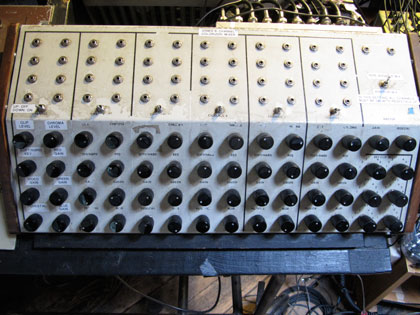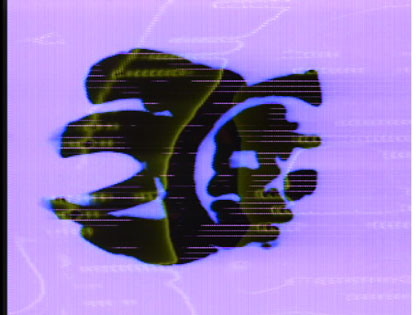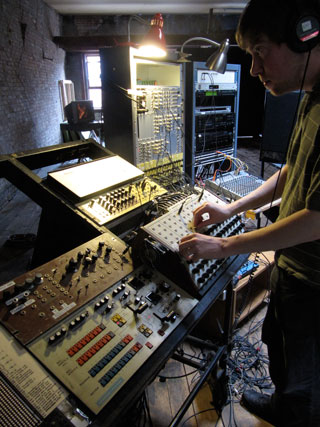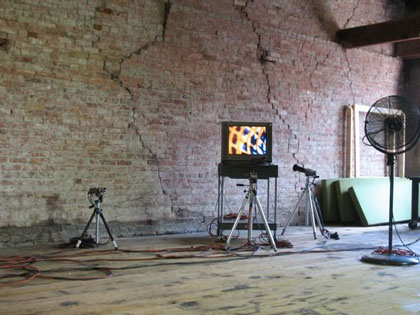Eclectronic Trajectories:
The Experimental Television Center
24 Sep 2011
Untitled (Cardifférance) from Carl Diehl on Vimeo.
"Art at its most significant is a distant early warning system that can always be relied on to tell the old culture what is beginning to happen." (Marshall McLuhan)
N
ot unlike other video makers, I stumbled upon the mesmerizing vortex of video feedback accidently, early on in my audio-visual career. As a teenage video hobbyist, feedback and other curious effects, uncovered through the mis-use of cable access video switchers, provided suitable means for representing a bevy of science-fictional phenomena in my high school productions. A few years later, as a student of Art Media Studies at Syracuse University, I was excited to learn that these videographic manifestations had a rich history, and one that emanated significantly from the very region of New York in which I lived. Along with Guerilla Television, Radical Software, the Videofreex and other early warnings of contemporary network culture, the Experimental Television Center, established by Ralph and Sherry Miller Hocking, outside of Binghamton in 1971, is a site that remains significant today. Beginning in the 1970s, artists were met with an opportunity to directly engage with the then new media of video mixers, synthesizers and colorizers. Emphasis was on self-guided exploration, access to the tools of television with an imperative of ever expanding beyond the conventional uses of these technologies.
Beginning in the 1970s, artists were met with an opportunity to directly engage with the then new media of video mixers, synthesizers and colorizers. Emphasis was on self-guided exploration, access to the tools of television with an imperative of ever expanding beyond the conventional uses of these technologies.
While video post-production has typically remediated the cinematic editing process, the Studio System, a non-linear matrix for inter-connecting the various a/v hardware at the Experimental Television Center, is designed to function as a live performance instrument. In this way, the Center's use of technology echoes Mcluhan's claim that artists are adept at pre-emptive insight. The Center's patch-based performance system, while sometimes likened to the unruly younger sibling of a traditional television studio, could instead by framed as the grandmother of contemporary digital performance software including Jitter, Isadora and Pure Data.
As a student in the late 1990s, I remember the many whispered accounts from within the Art Media Studies program that relayed tales of the Wobbulator, an audio-visual instrument fashioned by the legendary video artist Nam June Paik. Exploiting the synesthetic nature of electronic signals, the Wobbulator was a modified television set, re-wired to route audio signals to a series of extraneous deflection yokes. Amounting to interruptions of the regular electron beam itinerary, the video image could be distorted visually by the shape and behavior of any incoming audio signals. (Hocking, p.1) Ironically, it was not until I was geographically distanced from this increasingly resonant resource that I would manage to coordinate a spot in the residency program. Moving to the West coast in 2000, live audio-video performance has become a prominent part of my creative practice. Developing a repertoire of improvisational and orchestrated techniques, using both digital software and electronic video switchers, I remain particularly fascinated with the aesthetic possibilities of unintended or unexpected use of consumer media and electronics.

In early 2011, I received confirmation that my much belated pilgrimage to the Experimental Television Center was officially slated for late May. Soon after this announcement I learned the shocking news that the Center would be closing in July of this same year due to funding complications. The ante was upped, and I remained psyched, eager to make the most of this fateful opportunity. The following essay is an account of my time at the Experimental Television Center.
I began my residency at the Experimental Television Center on Thursday morning, 19th of May, 2011. With much appreciated and informative instruction from Hank Rudolph, I acclimated myself to the system. While I was puzzled initially, particularly by the daunting matrix board, I found the system was familiar conceptually by way of my experience with graphical programming environments.
I was early on enamored by the wobbulator, finding its eclectic electronic gestures to be elegant demonstrations of imaging processes distinctly unlike film or digital media. Working with isolated still images,Ispent a generous amount of the day honing my command of the wobbulator. Eventually I ran this tape back thru the system to experiment with permutations available on the Jones colorizer.

Into the night, the hallucinatory affect of the electronic permutations symbiotically directed my own caffeinated and sleep deprived imagination towards exciting new compositions --- I began to "perform" video via microphone and voltage controlled colorizer finding that the minutiae of mumblings, breaths and sound bursts could be echoed with nuanced visual murmurings. The Ross switcher assisted with complexity, introducing collateral keying and dissolve effects. My para-linguistic interests in "intonation" were then realized in series of recited word play, represented in real-time by equally absurd visual gestures!
Acknowledging, with humor, my somewhat loopy disposition and admiring similarly the connotations of "mad science" impressed upon me by the presence of ETC studio itself --- I set up a camera and recited a lecture on the "Polterzeitgeist" pulled from my repertoire of writings.
Subsequently, I re-routed this recording back into the system, wobbulating, re-scanning and adding collateral digital images from my laptop via the Jones Colorizer. I explored iterations of these sequences until the wee hours of the night finally eclipsed my ability to stay awake.
On Friday, I focused on combining the Jones colorizer and Ross switcher and, particularly,developing a more refined use of voltage control. From these focused studies I generated several mixes using previously prepared digital landscapes. Using multiple channels of the colorizer, additive and subtractive compositional processes propelled these digital fragments into electronically enhanced scenarios.

Mesmerized momentarily by an incredible rainbow arching over the Susquehanna River, in the wake of an evening downpour, I then supped and made haste for the Binghamton bus station. Emerging from that dreary bus station was part-time audio alchemist and long-time collaborator,Nat Hawks, arriving to assist with sound production. Returning to the ETC studio, we were quickly transfixed by the incredible alien sound-forms and accompanying video aberrations retrieved via the knob-twiddling of numerous oscillators.
Following a ridiculously inexpensive protein and caffeine boost at the Harris Diner on Saturday morning, dynamic duos proliferated within the ETC studio. Of these pairings, I might call attention to the dual/duel dance between video and sound, human imagination and the otherworldly electronic output, and the idiosyncratic sensibilities of Carl and Nat.
Returning to the ETC studio, we were quickly transfixed by the incredible alien sound-forms and accompanying video aberrations retrieved via the knob-twiddling of numerous oscillators.
Negotiated spatially, along an implied "z-axis" within Jones colorizer mix, a central muse or image became the "protagonist" in a series of burlesque caricatures of seemingly mundane source material. I found most striking and rich were slight abstractions of familiar objects. For example,a plastic bag, fluctuating in the wind and sunlight, could be de-contextualized by way of close-up videography. This initial ambiguity in scale, amplified within the mix, shifted associations towards high peaks and mountain ranges.
After several rounds of wildly diverse visual tone poems, Saturday night was met with relatively subdued audio-video alliances. At midnight, our weird vidsonic sorcery solicited a bat, vampiric or otherwise aligned, that fluttered incessantly around the studio. That this creature had mistaken our acoustic space as an inviting soiree, its bio-sonar perhaps jammed by our electronic emanations, remains to be determined. Truly, its arrival provoked only a temporary distraction from our production of pulsating audio-visual dirges.
Sunday morning we focused our energies exclusively on videographic interpretations of Nat's varied musical compositions. Responding to these twenty to thirty minute audio recordings, the Jones colorizer was utilized as a collaborative video performance instrument.

Of collisions and collusions, the kinetic presence of a spinning fan blade captured in real-time via BW camera, its wobbulated doppelganger, and the visual noise from another camera trained on an output monitor formed the basis for input into the Jones colorizer. These inputs were doubled up on the colorizer, so that each of us could control variations of the three incoming feeds. After an initial run, the feedback channels were replaced with the video recording of the antecedent mix and then recombined. This model of video synthesis prompted beautiful and strange visualizations in response to the musical accompaniment. Adapting this model to accommodate feeds from my laptop, output varied, moving intermittently between ambient color fields and pulsing geometric abstractions.
With approximately sixteen hours of recorded video output, editing will surely be necessary. My cryptic hand-scrawled tape labels bear witness to my own attempts at making this incredibly dense and heterogeneous opus navigable by my future self.
Digitization of these tapes will commence shortly, as there are a multitude of projects to be developed. Several 10 to 20 minute passages will hold their own as stand-alone audio and/or visual compositions and installations. There are many micro-loops to be extracted for use in digitally recombinant video performance palettes, too. I am certain that previously imperceptible meanings will be unearthed and re-contextualized in video montage projects for years to come!

In conclusion, my time at the Experimental Television Center was an immensely inspiring and invaluable experience! While I am saddened that these residencies will soon be ending, I am grateful for having had the opportunity to participate in this unique program. I hope that these eclectic imaging instruments, if not accessible for use, will remain on display as testament to the region's rich history of Video Art. More so, that the dedicated artists and engineers who pioneered, advocated, maintained and facilitated the Experimental Television Center will be celebrated and long remembered as champions of experimental practice, community access and the expressive potential of electronic cultural production.
*
Works cited:
Sherry Miller Hocking, Richard Brewster and Walter Wright "Raster Manipulation Unit: Operation and Construction"
http://www.experimentaltvcentr.org/history/tools/ttool.php3?id=28&page=1